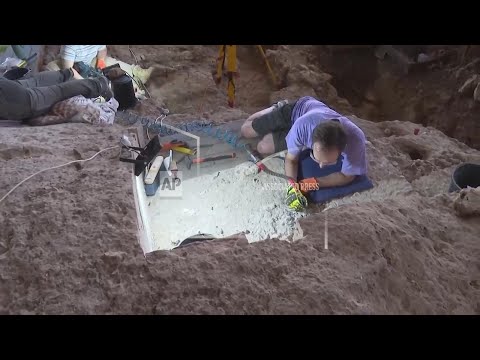(23 Jul 2025)
ISRAEL OLD BURIALS
SOURCE: ASSOCIATED PRESS
RESTRICTION SUMMARY:
LENGTH: 4:26
ASSOCIATED PRESS
Shoham, Israel – 15 July 2025
1. Various of archeologists working
2. Establishing shot of Yossi Zaidner, professor of archaeology, Hebrew University
3. SOUNDBITE (English) Yossi Zaidner, professor of archaeology, Hebrew University:
"This is probably one of the very few, if not the only site in the world right now in which you have human remains from 100,000 years ago under excavation. This is very unique and it’s today one of three or four most important sites for study of human evolution and behavior during the Paleolithic time."
4. Various of team digging
5. SOUNDBITE (English) Yossi Zaidner, professor of archaeology, Hebrew University:
"We have found several human skeletons, which are lying in a flexed position, which is usually interpreted as a burial position. And some of them have some burial goods with them, like antlers or basalt pebbles, which are brought from a distance. So there is something special about these people."
6. Various of researcher carving stone
7. SOUNDBITE (English) Yossi Zaidner, professor of archaeology, Hebrew University:
"One of the human habits, which we all have today, is a burial habit. We know that we are always taking care of our dead, we treat them, and we are burying them, okay. But this is a quite new habit in the history of humanity, and it starts about 100,000 years ago here, in our regio. And this place, Tinshemet cave is one of the earliest sites, together with two other sites."
8. Pan on site
9. SOUNDBITE (English) Yossi Zaidner, professor of archaeology, Hebrew University:
"One of the causes of this interaction was behavioral innovation that we see during this period of time. And one of these innovations is burials. So what we think that this interaction, that we can see clear evidence for cultural transmission and for knowledge transmission between different populations, probably led not only to learning and transmission, but also to some pressure."
10. Chunk of ochre on stone
11. UPSOUND (English) Yossi Zaidner, professor of archaeology, Hebrew University
"This is a chunk of ochre, a material from which they produced a color, a red color. And probably they use it in order to paint themselves or their bodies."
12. Various of Zaidner with team looking at what they found
13. SOUNDBITE (English) Yossi Zaidner, professor of archaeology, Hebrew University:
"What we can see now here, that actually all of the region was kind of interconnected. It was a net and people were very mobile and the population were interconnected, and they were bringing materials from different directions."
14. Wide of researchers at site
15. Pan of the area
STORYLINE:
Archaeologists in Israel have concluded that the well-preserved, 100,000-year-old remains of early humans, carefully arranged in pits in the fetal position, are from one of the oldest known cemeteries in the world.
The findings at Tinshemet Cave in central Israel, published in an academic journal in March, build on previous discoveries nearby and add to a growing understanding of the origins of human burial.
Of particular interest to archaeologists are objects found beside the remains that may have been used during ceremonies to honor the dead and could shed light on how our ancient ancestors thought about spirituality and the afterlife.
Archaeologists working at Tinshemet since 2016 have discovered the remains of five early humans that date back to around 110,000 to 100,000 years ago, according to various technologies.
Find out more about AP Archive: http://www.aparchive.com/HowWeWork
Twitter: https://twitter.com/AP_Archive
Facebook: https://www.facebook.com/APArchives
Instagram: https://www.instagram.com/APNews/
You can license this story through AP Archive: http://www.aparchive.com/metadata/youtube/63a21a15362b4d9098de20d8f3c88b95
Author: AP Archive
Go to Source
News post in July 28, 2025, 12:05 pm.
Visit Our Sponsor’s:
News Post In – News





